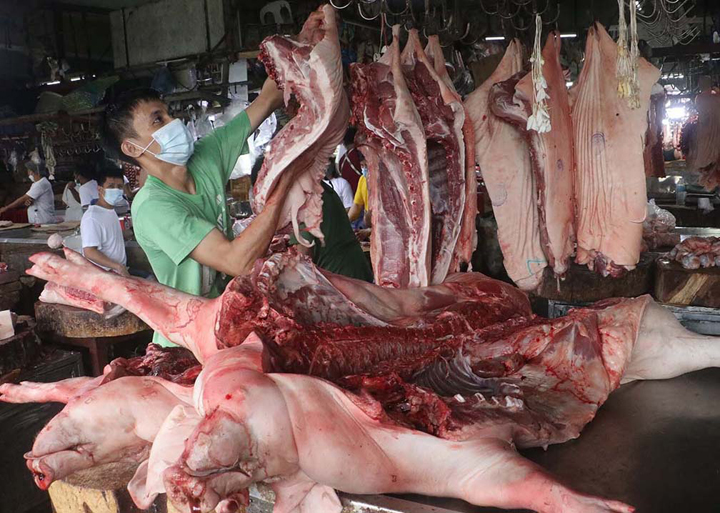
THE government’s revenue losses due to reduction of pork tariffs have reached P3.4 billion as of mid-November, the customs bureau said, amid concerns over the effectiveness of the measure.
In a statement, the Bureau of Customs (BOC) said the government has foregone some P3.4 billion in revenues since tariffs were slashed from April 7 to November 12. The BOC added it had collected P3 billion in revenues from 197,000 metric tons (MT) of pork imports during the reference period.
“To compute the effect of the two EOs, we multiplied the dutiable value of meat by 25 percent—less 5 percent and 15 percent—which were already paid for EO 128, and multiplied the dutiable value by 20 percent and 15 percent for EO 134. The result showed a revenue loss of P3.4 billion,” BOC Commissioner Rey Leonardo Guerrero told a recent Department of Finance (DOF) executive committee meeting.
Last week, lawmakers raised concerns on the effectiveness of the twin measures to address elevated pork retail prices: the reduction of tariffs and expansion of the pork minimum access volume (MAV).
A joint hearing by the House Committee on Agriculture and Committee on Trade and Industry saw lawmakers grilling agriculture officials on whether the twin measures have lived up to their promise seven months after.
“Maybe the EOs we made were mistakes because the measures we hoped to be the solution to the high prices of pork, as it turns out—fast forward today after six months, did not pull down pork prices to August 2020 levels,” Deputy Minority Leader Stella Luz A. Quimbo said during the hearing.
“We lost a lot of tariff revenues,” noted Quimbo, adding that “maybe,” giving “those losses as ayuda to hog raisers” is a better option.
“Perhaps, we made a mistake with that policy and we better look for alternative solutions because clearly we have not received any reprieve at this point in time,” Quimbo added.
Agriculture officials defended the twin measures and explained that the benefits are not yet fully realized because numerous non-tariff measures delayed and derailed the arrival and distribution of imported pork in the market.
National Federation of Hog Farmers Inc. (NFHFI) President Chester Warren Y. Tan concurred in Quimbo’s statements, saying the measures may be deemed a success if consumers indeed benefited from them.
“There is no problem if the consumers really benefited from it, but they did not. We lost government revenues, the consumers did not benefit, and the private hog industry stakeholders are affected,” Tan told the BusinessMirror.
Wrong tariff rates
An initial analysis by BusinessMirror of publicly available customs data—validated by the Federation of Free Farmers (FFF)—showed the government incurred about P3.3 billion in losses from April 7 to end-October.
In arriving at the estimate, the BusinessMirror calculated the difference between the duty paid by importers under the lower tariff rates and the duty owed to the government at a regular tariff level. The dutiable value of imported pork was then used in computing the losses, the same figure used by BOC.
Customs’ data sets on import filings showed that certain imports were assessed with tariffs that should have been phased out during a given period.
For example, some 434.815 MT of pork imports worth P35.344 million were filed by importers under the 5-percent tariff rate from June to August. The 5-percent tariff rate on in-quota imports, through Executive Order EO 128, only lasted from April 7 to May 14, following the issuance of EO 134 that superseded earlier rates.
Based on BOC data, government lost some P93.859 million of revenue due to incorrect tariff rates applied for certain pork imports from June to October, nearly equivalent to one-fourth of the government’s P400-million swine repopulation program.
Industry groups such as FFF, Philippine Chamber of Agriculture and Food Inc. (PCAFI) and NFHFI have urged customs to investigate the discrepancy in tariff rates to ensure the government gets the correct revenue, which could be used to bankroll programs to revive the domestic hog industry.
FFF National Manager Raul Q. Montemayor said the BOC must explain why there were incorrect tariff rate applications when in fact import filings are made electronically.
“Someone has been remiss in their duty. It could be the one on top or people on the ground are not following orders. We need every centavo of revenue right now and they should not sit with this problem as if it does not mean anything,” Montemayor told the BusinessMirror.
In previous years, his group learned that certain rice imports were levied the wrong tariff rates but these have been resolved already by the BOC.
The BusinessMirror sought BOC’s comment on the incorrect tariff rate applications but it has not responded as of press time.
Based on BusinessMirror analysis, the average landed cost of pork per kilogram under the lower tariff rates is P101.09 per kilogram. The government loses about P18.24 per kilogram of imported pork due to lower tariff rates.

